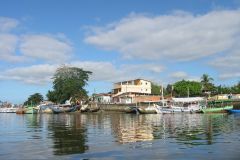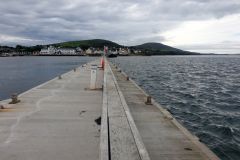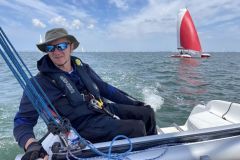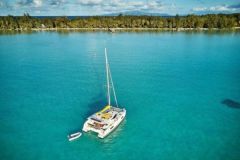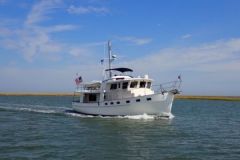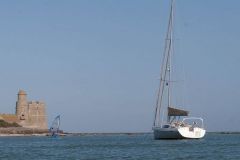?Le why and how of the Mediterranean anchorage
This type of mooring is a hybrid between anchor mooring and dockside mooring. It can only be envisaged in areas without tidal ranges, so this practice is particularly widespread in the western and eastern Mediterranean.
In harbours that are very busy but offer little infrastructure to visitors passing through, dead-end mooring allows the number of boats moored to be optimized. In addition, this type of mooring helps to avoid the effects of rolling when other boats pass by.

Principle of the Mediterranean anchorage
The principle is fairly simple to describe, it's to drop anchor in the middle of the harbour, back up to the wharf and moor there.
In practice, it will be necessary to have a good knowledge of the boat's manoeuvrability in reverse, its behaviour in crosswind conditions, and how to bring the boat's mooring lines to the dock.
Tips and tricks: If it is a rental boat, do not hesitate to make a first (second or even third) approach to familiarize yourself with manoeuvrability and dunnage.
Tips and tricks: A boat is often sensitive to the pitch of the propeller: when the reverse gear is engaged, the stern will go to port or starboard (and the bow obviously the opposite). It is necessary to use the propeller pitch effect to successfully complete the first phase of the approach.
How do I make a success of the ass mooring at quai??
You need to observe the space you wish to occupy to prepare the proper mooring. Try to see if you are dealing with sealed rings on the wharf walls or mooring bollards. Are there other bateaux?? How high is eau?? Is there a mariner on the dock to take your amarres??
Preparation of the boat
- First of all, prepare the boat with enough fenders to protect the transom, they will be the ones leaning against the dock. If you have to sit next to another boat, you will also dress your fenders.
- Prepare a minimum of two rear hawsers, make sure they pass on the right side of the balconies and that they are long enough to pass them in duplicate.
- The anchor must be ready to be used: the windlass powered at the electric panel, any remote control connected, anchor safety removed. A small test to lower the anchor by a few centimetres is not superfluous.
- To facilitate manoeuvring, the ideal is to have 3 crew members: the first at the bow for anchoring, the second at the helm and the engine and the third for mooring at the quayside.
How far from the dock is ancre??
It is difficult to give a distance to the dock that corresponds to all cases. The correct mooring length depends on the depth, type of bottom, dunnage and weight of the boat, but also on the mooring available and of course the weather conditions. Let's say that if we anchor 4 boat lengths we can spend a peaceful night. But, if the wind is forecast to be strong, don't hesitate to anchor longer.
Step-by-step method
1 - Locate the place where you are going to anchor. Your anchorage must form a perpendicular with the dock, this is the best guarantee to avoid the anchoring chains of different boats crossing each other. Once you have determined where you want to drop anchor, make a slow approach and move a little beyond the place where you want to drop anchor.
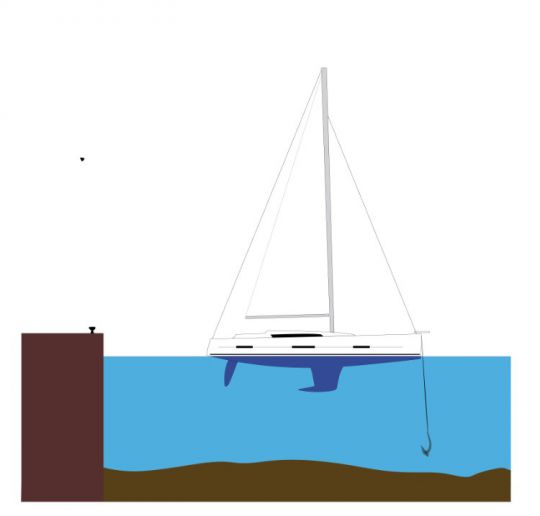
2 - Engage reverse gear, there is a certain amount of inertia before starting to reverse. So take a marker and as soon as you notice that the boat is backing up, it is time to let go of the anchor. Maintain enough speed to maneuver and keep the boat on course, the bowman must adjust the flow of the chain.
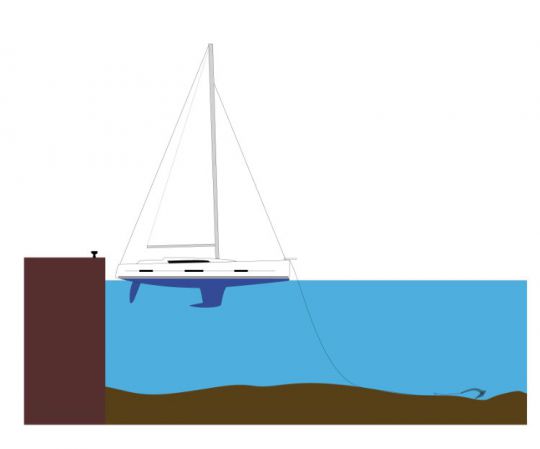
3 - A few meters from the dock, slow down your reverse gear and the chain descent in order to arrive dead-ends to the dock almost stopped. With some boats, it will be possible to hold the boat against the dock with a light support of the reverse gear, which will facilitate the descent of a crew member to pass the hawsers.
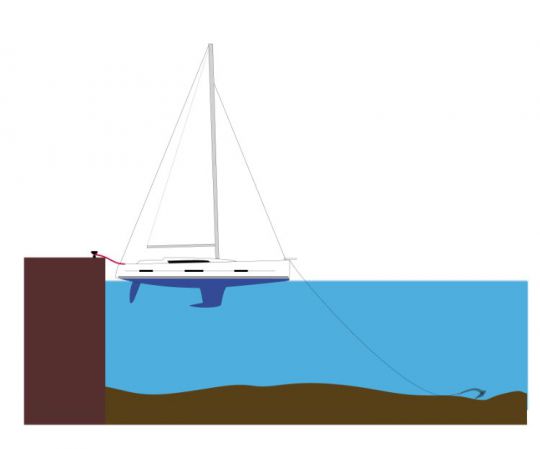
4 - Once the mooring lines are in place, all that remains to be done is to adjust the distance to the quay, and take up the chain tension to tighten the hawsers.
That's it, the maneuver is réussie?! Let's admit that it's often simpler to describe than to do. A boat with a large propeller pitch or a crosswind can ruin your trajectory in reverse, but with a little practice this maneuver is accessible to most people.







